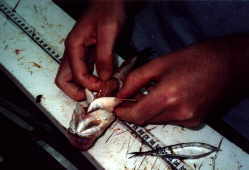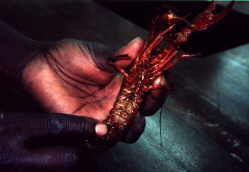Introduction
The aim of the project was to assess the present status of the fish population
of Lake Naivasha following the:
- opening of the commercial fishery in early 2002 following a period of
closure;
- introduction of the common carp, Cyprinus carpio L. in 2001.
In addition, work was completed on the crayfish population of the lake. These data were collected to supplement the long-term crayfish study in Lake Naivasha. This investigates crayfish density in the littoral vegetation and their mean carapace size in both the littoral vegetation and open water habitats.
Secchi disk readings were also taken at all netting sites.
Fish
Using gangs of gill nets comprising of mesh sizes of between 8 and 50
mm, the fish population of the lake was sampled at 5 locations; Joan Root's,
Hippo Point, North Swamp (Loldia Hotel), open water outside Crescent Island
and inside Crescent Island. This sampling regime ensured the major fish
habitat types of the lake were sampled at least once.
The principal fish species sampled at all sites was Tilapia zillii (Gervais). The distribution of the other major fish species in the lake, Oreochromis leucosticus (Trewewas), Micropterus salmoides Lacépède and Barbus amphigramma Blgr. was more patchy, with their distribution reliant on the habitat being sampled. O. leucosticus was found mainly in open water sites, M. salmoides in the rocky margins and B. amphigramma in the North Swamp.
There were no samples of C. carpio caught in the Earthwatch gill nets, but samples were collected from the commercial fish-landing beach. It appears from these catches that their population remains low in the lake with fish present between 250 and 500 mm, sizes that may preclude them from the Earthwatch gill nets. These data indicate that C. carpio has either yet to reproduce in Naivasha or has done so with only limited success and, therefore, has yet to establish.
Dietary analysis of M. salmoides revealed the species to be a generalised macro-predator within the lake. Diet composition was similar to previous years. At sizes up to 200 mm, invertebrates - principally Micronecta spp. - were the main food item. As body and gape size increased, there was a dietary shift towards fish and adult crayfish. At sizes of over 300 mm, adult crayfish comprised 89% of all ingested food items.

Dr. Britton shows the gap on one Micropterus salmoides
Stomach samples were taken from T. zillii, O. leucosticus
and C. carpio in order to ascertain if there was any overlap in
their diet at present. This may indicate any potential for competition
between the species should C. carpio become established in Lake
Naivasha in future. These samples will be analysed in the UK.

Volunteer Mark Tretter examines stomach contents
It is hoped that the fish population data can be used for the following
outputs:
- a short communication on ‘The introduction and potential impact
of Cyprinus carpio L. in Lake Naivasha, Kenya';
- a paper on ‘The effect of the commercial fishery closure on the fish population of Lake Naivasha, Kenya, and the implications for management.' This would require analysis of catch statistics from the period before and after closure and Earthwatch gill netting data from before, during and after closure.
Both papers would require collaboration between workers in the UK and Kenya.
Crayfish
The crayfish were sampled in the littoral vegetation using a 1 m2 quadrant
and in the open water using 6 baited crayfish traps.
The density of crayfish in the littoral vegetation revealed their population was returning to levels last seen in the late 1990s, the period before the boom (~600 m2) and bust (~10 m2) population cycle of 2000 and 2001. The average density for all sites was 45 m2. However, their distribution was patchy in the lake. This was irrespective of actual water hyacinth coverage in the sampled areas. In areas around Joan Root's and Hippo Point, crayfish density in the littoral vegetation was typically between 30 and 150 m2, with an average of 49 and 63 m2 respectively. At the North Swamp, in the margins around the Loldia Hotel, crayfish density was comparatively very low, with an average density of only 18 m2.

Rueben demonstrated proper grasping of crayfish
These data were in contrast to the crayfish numbers captured by the traps. Numbers of trapped adults at both Joan Root's and Hippo Point were very low, average <1, maximum 4. This contrasts to an average of 19 per trap at Loldia Hotel, with a maximum of 34. At Loldia Hotel, the sex ratio was 27% female and 73% male. This may indicate a breeding area for the crayfish in the North Swamp with subsequent dispersion of juveniles to more favourable nursery areas.
In terms of mean carapace size, the average in the littoral vegetation (quadrant) was 17 mm and in the open water (traps) 45 mm. This reveals the juvenile crayfish preferred the refuge of the littoral vegetation with a gradual dissociation from these vegetated areas with increases in carapace size.
Conclusions
Future work is necessary on the fish population to monitor if C. carpio
does successfully reproduce and establish in the lake. If this does happen,
monitoring of the fauna and flora of the whole lake will need to be continued
as the species can be very destructive in their foraging activities among
the lake benthos. C. carpio is considered a pest species in many
countries, including Australia and South Africa, due to their negative
impact on water turbidity and macrophyte growth, with eradication programmes
designed to remove them totally from aquatic eco-systems.
Overall, I believe the work on the fish and crayfish provided a good range of activities for the volunteers to participate in, with both projects complementing each other due to the prevalence of crayfish in aspects of the diet of M. salmoides. I believe both work aspects achieved their intended aims and provided interesting and thought provoking discussions among the volunteers.

Second from the left is Dr. Britton
shown with his third Earthwatch volunteer team:
Justin, Naomi, Carol and Mark
